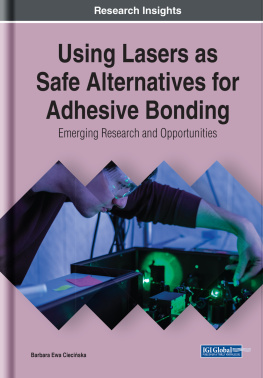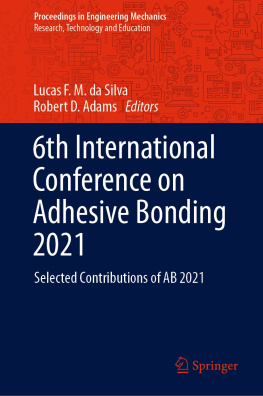Chapter 1
Adhesive Bonding:
Types of Adhesives and the Preparation of an Adhesive Mixture
ABSTRACT
This chapter presents the application of adhesive bonding technology with a long tradition of use in manufacturing processes. It has an established position among a number of different ways of permanently joining elements together. This work offers a list of many advantages of this technology, alongside the difficulties and limitations in the use of adhesive bonds. The basic concepts of adhesives and their components are described, and the terms related to the bonding process are presented. Attention was paid to the great variety of adhesives and many different criteria of their division and selection to a particular technological situation. In the following chapter, examples of the application of different types of adhesives with regard to using materials and constructions can be found as well as methods and requirements for the preparation of the finished adhesive. Mechanisms of the formation of an adhesive bond are characterized, and various constructions of adhesive bonds that are necessary to form a durable bond of elements are presented.
APPLICATION OF ADHESIVE BONDS
Currently, adhesive bonding has a strengthened presence in the industry as a technique of connecting elements together. In the production of a wide variety of products, there is a large number of components that are permanently bonded together in this way. It is not possible to separate the bonded parts without destroying them, as opposed to the equally commonly used separable connections, e.g. twisting (Sobieszczaski J., 2004).
However, despite some inconveniences, adhesive bonds are used in almost all industries. One of such industries is the furniture industry, where furniture structures, upholstery and decorative elements are bonded together. Adhesive bonding connects elements of various types of metal tanks, packages of transformer plates. In addition, adhesive bonding is increasingly replacing classic methods of bonding used in machine and vehicle construction, for example, to connect parts of bodies made of steel or aluminum plates (where adhesion takes place in welding or soldering, especially in hard-to-access places or elements vulnerable to high temperature deformality) (Sobieszczaski J., 2004).
In automotive industry, entire car bodies are adhesively bonded together - the first Ford Taunus construction in 1960 may be a distinct example of it. In this first Ford construction, engine and boot covers, fenders and a folding roof were bonded together with synthetic rubber adhesive. In the automotive industry, sealing pastes made of polyvinyl chloride are also used. For example, in 1949 Chrysler replaced riveting of brake linings with adhesive bonding using phenol-formaldehyde resin (Kniewald D., 1994).
Adhesive bonding has become a particularly useful technology in aviation and cosmonautics as it is possible to manufacture ultra-lightweight, yet very durable structures. Reduction of aircraft weight by 1 kg leads to savings of about 20 to 40 thousand dollars. Covering the outer jacket of space shuttles (e.g. Columbia) with 30 000 bonded silicon wafers as a thermal shield, resistant to temperatures of 1500C is a well known solution. Another characteristic structure among flying objects is the so-called honeycomb structure bonded in, among others, rotor blades of helicopters Mi 2 (Cagle Ch. V., 1977).
In the machine industry, in assembly operations, adhesive bonding makes it possible to eliminate backlash, fill gaps, ensure tightness of the structure, protect against loosening and vibrations in screw, pin, spline and hub-shaft connections. Thus, it is possible to extend the life of the product and reduce the costs associated with labor-intensive processing (Puff T. & Sotys W., 1980).
Adhesive bonding is also used to repair damaged machine elements, for example to fill in short run castings or cracks in cast machine bodies and to regenerate worn surfaces working in sliding connections. For example, when an adhesive layer is applied to a worn journal, the adhesive layer is turned to the desired journal dimension after curing (Sobieszczaski J., 2004). As a structural repair technique, bonding is also used in military applications as it is easy to perform operations with adhesives under field conditions. Examples are resin filling in pump bodies, sealing of radiators, motor vehicle engines caused by intensive exploitation or the effect of using arms. In combat conditions, metal tanks, rubber elements of tires and aluminum linings are bonded together. It is common practice to reproduce the damaged structural elements using adhesives, which is useful especially in situations where it is not possible to perform a professional repair. In this way, the replacement element is used on an ad hoc basis and the device recovers its function. To repair combat equipment, the so-called adhesive composites are used, i.e. resins with fillers, e.g. in the form of textiles, foams, metal cores. A good application example are BELZONA materials used by armies of different countries in NATO (Godzimirski J. & Others, 2010).
Unusual applications of adhesive bonding operations include bonding in medicine not only to manufacture laboratory equipment, but also to tend cuts. The surgery of adhesive bonding of the severed body enables faster closure of traumatic and surgical wounds compared to traditional sewing. Additionally, cosmetic appearance of the scar is similar to the one treated in a traditional way. The first adhesives used with tissues turned out to be toxic, however further research in the first half of the 1970s resulted in non-toxic fibrin binders used to bond cuts, nerves, trachea, bronchi and bone adhesives. Another example of bonding applied in medicine is the UV-curing adhesive used in dentistry, invented in the 1990s (Godzimirski J. & Others, 1997).
At the current stage of development of adhesive technology, there are many possibilities to select an appropriate adhesive for suitable production or application requirements. There are adhesives known to be cured only in water, humid air environment or in atmosphere free of any traces of water vapor. There are also adhesives that cure in the presence of oxygen or in oxygen-free presence. In addition, some adhesives are suitable for joining steel elements operated at elevated temperatures and others at low temperature (Czaplicki J. & Others, 1987). The variety of adhesives makes it possible to successfully apply adhesive technology in many manufacturing processes.
ADVANTAGES AND DISADVANTAGES OF BONDING
Adhesive bonding is a technique of connecting materials together. In principle, it can be said that the available adhesives allow to combine all solids with each other, i.e. metals with metals, but also with rubber, plastics, wood, ceramics, glass, etc. There are also hybrid connections used between different metals: aluminum steel, titanium alloy steel, plastic with wood, etc. (Czaplicki J. & Others, 1987).
In many cases, bonding is characterized by features not possible to obtain with other methods. At the same time, a lightweight, durable, rigid connection is obtained in an economical and efficient way. It should be remembered, however, that adhesives and glue joints are characterized by undoubted advantages, yet also have certain disadvantages and limitations (Cagle Ch. V., 1977).
From among many advantages of bonding, the following may be distinguished: (Godzimirski J. & Others, 2010; Brockmann W. & Others, 2009; Sobieszczaski J., 2004; Rokowicz M., 2013; Cagle Ch. V., 1977):
- 1.Possibility to combine materials differing in structure and properties (e.g. in the case of metals, an important feature is the possibility to combine materials with a different melting point).









